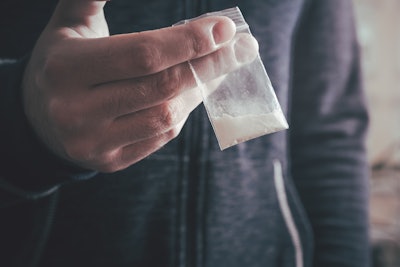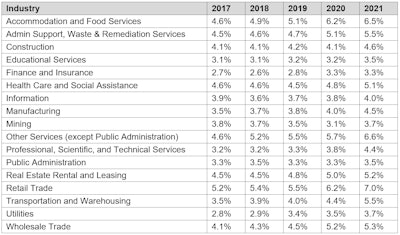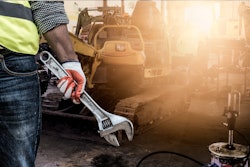
After holding steady between 2017 and 2020, construction’s rate of positive drug tests increased by 12 percent from 2020 to 2021, according to the latest Quest Diagnostics Drug Testing Index.
However, this upward trend is not limited to construction. The rate of positive drug-test results among America's workforce reached its highest rate last year since 2001 and was up more than 30 percent in the combined U.S. workforce from an all-time low in 2010-2012.
Among all industries, construction fell in the middle of the pack for overall drug positivity rates at 4.6 percent, behind such sectors as retail trade, accommodations and food services, and waste and remediation services.
While positive cocaine urine drug tests have steadily declined in construction, the industry topped the list for the fifth year in a row with a 0.30 percent positivity rate in 2021. The wholesale trade industry came in second at 0.26 percent. Construction also ranked the highest for methamphetamine positivity at 0.20 percent, with mining coming in fourth at 0.16 percent.
Construction’s positivity rate for marijuana grew 16 percent year-over-year but was still significantly behind other industries at 2.9 percent. Comparatively, the accommodations and food services industry reported a 7.5 percent rate of positive marijuana urine drug tests.
Opiates positivity rates in the mining segment ranked the highest among other reported industry segments, coming in at 0.43 percent, compared to construction’s 0.13 percent. Still, the 0.43 percent is the lowest percentage of opiate positivity rates in the mining industry in the past five years of the index, says Quest.
 Quest
Quest
The Bigger Picture
Quest says the study, based on more than 11 million annonymized urine, hair and oral fluid drug test results, raises concerns for employers in safety-sensitive work environments such as construction.
"Our Drug Testing Index reveals several notable trends, such as increased drug positivity rates in the safety-sensitive workforce, including those performing public safety and national security jobs, as well as higher rates of positivity in individuals tested after on-the-job accidents," said Barry Sample, senior science consultant for Quest Diagnostics.
"Employers are wrestling with significant recruitment and retention challenges as well as with maintaining safe and engaging work environments that foster positive mental and physical wellbeing," said Keith Ward, general manager and vice president, Quest Diagnostics Employer Solutions. "Our Drug Testing Index data raises important questions about what it means to be an employer committed to employee health and safety. Eager to attract talent, employers may be tempted to lower their standards. In the process, they raise the specter of more drug-related impairment and worksite accidents that put other employees and the general public in harm's way."
Marijuana usage continues to climb as states wrestle with legalization. Positivity rates for marijuana in the general U.S. workforce increased 8.3 percent (3.6 percent in 2020 versus 3.9 percent in 2021), the highest positivity rate ever reported in the DTI. Over five years, positivity for marijuana in the general U.S. workforce has increased 50 percent.
While pre-employment drug tests are meant to be a deterrent in hiring workers whose drug-use behavior could cause unsafe work conditions, an increase in post-accident testing suggests that more drug-associated accidents are occurring, compromising the safety of other workers and the public.
In 2021, urine post-accident testing in the U.S. general workforce for marijuana and cocaine had a positivity rate of 63.4 percent and 266.7 percent higher, respectively, as compared to pre-employment tests. For the two groups of semi-synthetic opiate drugs – opiates (hydrocodone/hydromorphone) and oxycodones (oxycodone/oxymorphone) – in these tests, post-accident positivity was 316.7 percent and 200 percent higher, respectively, than in pre-employment testing.
The Quest index looks at positivity laboratory test results it performs for a range of illicit, legal and prescription drugs, examining three categories of workers: federally-mandated, safety-sensitive workers such as truck drivers and pilots; the general workforce; and the combined U.S. workforce.















